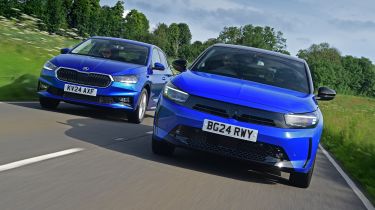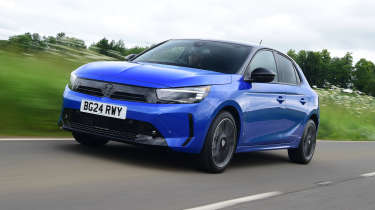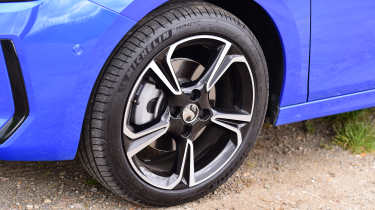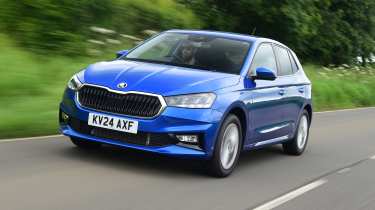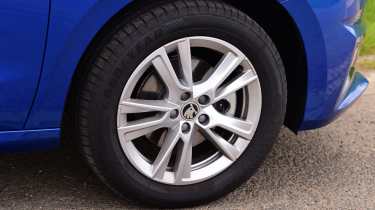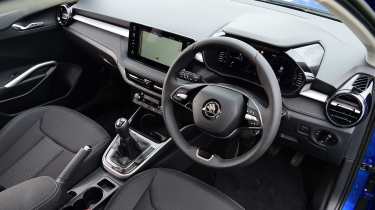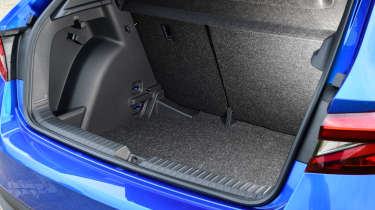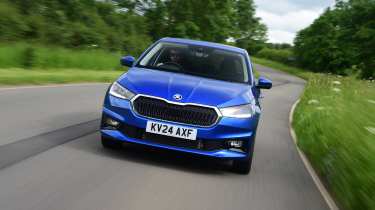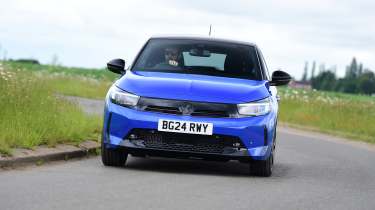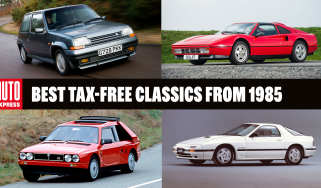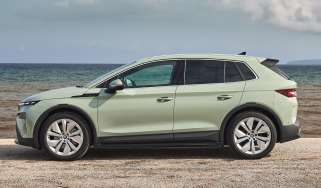Vauxhall Corsa vs Skoda Fabia: we find the superior supermini
Cars such as the Corsa and Fabia give you supermini strengths without the sacrifices you once had to make. But which is best?
There was a time when choosing a supermini meant that you had to compromise. In years gone by, small cars sacrificed refinement, equipment and performance all in the name of keeping prices and running costs down.
Now however, there are a number of supermini options that really feel as if you can have your cake and eat it. Take the latest version of the Vauxhall Corsa. It’s more grown up, more substantial and more relaxing to drive than ever before; and thanks to the introduction of a new hybrid powertrain, it promises to be one of the most fuel-efficient examples of the model that we’ve ever driven.
To put it to the test, we’ve lined up a small car that has always held maturity as one of its greatest strengths. The Skoda Fabia is a model that has crammed the company’s traditional values of space, comfort and value for money into a dinky package – and following a small update for 2024, we’re keen to see if it remains as strong as ever before. To find out which is model best, we face the pair off in our Real-World Road Test.
| Skoda Fabia | Vauxhall Corsa Hybrid 1.2 100PS GS | |
| Price: | £23,415 | £25,280 |
| Powertrain: | 1.0-litre 3cyl turbo petrol, 114bhp | 1.2-litre 3cyl turbo petrol hybrid, 99bhp |
| 0-62mph: | 9.7 seconds | 10.7 seconds |
| Test efficiency: | 60.1mpg/13.2mpl | 55.4mpg/12.1mpl |
| CO2: | 119g/km | 104g/km |
| Annual VED: | £180 | £180 |
Vauxhall Corsa
The hybrid edition adds another level of electrification to the Vauxhall Corsa line-up, joining the range’s pure-petrol and fully electric options. We’re testing it in mid-spec GS trim, but at £25,280, it looks a bit pricey when compared with the Fabia.
Tech highlights
Late 2023 saw the Corsa treated to a mid-life refresh that added a sharp new design, featuring the brand’s ‘Vizor’ front end, plus improvements to the in-car tech and trim materials. However, we’ve had to wait another six months for a significant mechanical upgrade to arrive. The eight-speed automatic gearbox has been dropped from the 1.2-litre turbocharged petrol engines, and is replaced by a new hybrid set-up.
This uses a 48-volt electrical system that draws energy from a 432Wh battery, and sends it to an electric motor with 28bhp and 55Nm. The motor sits within a new six-speed dual-clutch automatic transmission, and the system offers a choice of outputs. The first produces the same 99bhp as the old entry-level petrol auto, while the more potent version has 134bhp, which is 5bhp up on before.
It’s not outright performance but efficiency that’s the focus here, though. In the case of the 99bhp model we’re testing, it consumes 20 per cent less fuel than the car it replaces, according to the official WLTP figures. If you accelerate gently enough and there’s sufficient charge in the battery, then the Corsa Hybrid is able to drive on electric power alone at speeds of up to 18mph.
Safety: The Corsa was tested by Euro NCAP in 2019, when it achieved a four-star rating. It’s fitted with a lane-departure warning system that is easy to turn off with a long press of a button on the centre console, although regulations dictate that it reactivates when you next turn on the ignition.
On the road
The hybrid system is a vast improvement over the old auto to drive, while the same decent – but not class-leading – chassis remains unchanged.
Around town: There is a very pleasant side effect to the new hybrid system that presents itself at low speeds. The old eight-speed auto was almost impossible to drive smoothly in slow-moving traffic, with its poor calibration between the brakes and the start/stop system causing jerky halts that made you look like a struggling learner.
This feeling is completely absent from the new car; the brakes are much easier to modulate and the electric motor ensures stopping and moving off again is almost seamless. The electric motor does give off quite a pronounced whine, though.
A & B-roads: As speeds increase, the Corsa feels largely similar to earlier models, which is no bad thing. The 1.2-litre unit has never been short of low-down grunt, making it feel livelier than the 99bhp figure suggests. It’s the same here, and its strong response at low engine speeds means the gearbox only kicks down under hard acceleration.
Engine braking was also lacking before, but due to motor regeneration, which tops up the battery when slowing down, the Corsa can hold a steady speed when going downhill – something that you could only achieve previously by riding the brakes.
Handling is fine for the class. The slightly vague steering takes the edge off the fun, but body roll is well contained and the chassis feels fairly agile.
Motorway: The flip side of the composed handling is the Corsa can feel a little bouncy over many road surfaces, even as you move towards motorway speeds. While the ride is never harsh, you sometimes wish it would settle a little more.
Ownership
A mid-life refresh introduced a few subtle changes to the Corsa’s cabin. The seat upholstery is new, while the centre boss of the steering wheel gets a more prominent centre that mimics the ‘Vizor’ grille. But most importantly, it gets a boost in tech, courtesy of a new 10-inch touchscreen system – more on which in the infotainment section later.
Overall, the design and finish have changed very little, so cabin quality is a little behind the class best, with hard, scratchy plastics in places that are within easy reach, such as the door panels. The layout is also a little plain, but it is functional. If we’re being fussy, the rotary dials for the climate controls are a little small, but we’re just grateful that Vauxhall is sticking with physical controls and not confining them to a touchscreen. The driver’s seat has plenty of adjustment back and forth, and, slightly small rear window aside, all-round visibility is reasonable for the class.
Storage: As with many Stellantis-based small cars, the Corsa’s glovebox is in effect halved in size because of the placement of the fuses in the space behind the door on right-hand-drive cars.
Storage elsewhere is a little compromised, too; the door pockets are slim (although they do have just enough space to hold a water bottle) and the cubby at the base of the dashboard isn’t quite large enough to lay a large smartphone flat inside it. The central cup-holders are reasonably deep, though.
Practicality
If you’re only carrying two people, then the Corsa is a perfectly fine supermini. But further back, space isn’t one of the Vauxhall’s strong points.
Rear Space: By class standards, the Corsa’s rear accommodation is a little tight. Both knee and headroom are below average, but we did find the sculpted design of the outer two seats to be comfortable and supportive. If you want to install a child seat, the mix of small rear doors and ISOFIX mounts hidden behind fiddly zipped covers makes the processa little trickier than we’d like.
Boot: A 309-litre boot volume is towards the lower end of what is offered by the latest superminis, plus the load lip is higher than many rivals’. That capacity grows to 1,118 litres with the seat backs folded, but they don’t lie completely flat, which leaves a step in the load floor.
What to buy?
Which version we’d choose...
- Powertrains: The hybrid powertrain is only available with the automatic transmission; if you want a manual gearbox, the options remain the same two options as before, with 99bhp and 128bhp. There’s also a couple of EV editions; these have 134bhp and 154bhp, with the latter getting a slightly better range thanks to a more energy-dense battery that has a bigger capacity.
- Trim: There are four trims offered, but the Yes trim can’t be paired with the hybrid powertrain. Design misses out on the GS’s all-round parking sensors and reversing camera, but costs £2,715 less.
- Our choice: Base Design trim is the Corsa Hybrid that offers the best value for money.
Skoda Fabia
While the Skoda Fabia tested in these images has a six-speed manual gearbox, we’re testing it with an optional automatic gearbox to make it a match for the Corsa. With a DSG auto and in SE L trim, the Fabia costs £23,415, but there is a reason why that price undercuts the Corsa by £1,865.
Tech highlights
That margin is down to the Skoda using a simpler powertrain. While the Corsa makes use of the Stellantis group’s latest hybrid tech, the Fabia is a pure-petrol model instead. There’s only one mechanical change for the 2024 model; the Skoda now comes with a revised version of the 1.0-litre TSI petrol engine, known as TSI EVO2.
As with the Corsa, it uses a turbocharged three- cylinder unit, but the Skoda’s gives away 200cc to its competitor here, offering 999cc of capacity. Despite its smaller displacement and the lack of electrical assistance, the Fabia’s engine is more powerful – at 114bhp, it has 15bhp more than the Corsa (and 6bhp more than its predecessor) – and its 200Nm of torque is just 5Nm short of its rival’s figure. On paper, there’s just 12kg between the two cars’ kerb weights (in the Vauxhall’s favour).
Elsewhere, the Czech supermini benefits from extra standard equipment on all models. Even the entry-level cars now get a digital driver’s display that measures at least eight inches, while privacy glass, a hill-hold system and LED tail-lights are new features on the SE L model tested here.
Safety: The Fabia scored a maximum five-star rating when it was tested by Euro NCAP in 2021. While traffic-sign recognition is now fitted as standard on every model, it’s a bit of a shame that if you want to add a driver’s knee airbag and side airbags for the rear-seat passengers, then you’ll need to stump up another £545.
On the road
For the overwhelming majority of buyers, the Fabia is the best supermini to own right now. Keen drivers should look elsewhere, but the things that matter to most motorists – comfort, stability and refinement – are all areas where it excels.
Around town: Light, accurate steering, a smooth engine and a soothing ride make driving the Fabia at low speeds a pleasure. The ride is the standout feature; where the Vauxhall can occasionally jiggle around, the Skoda shrugs off many of the same bumps. Some harsher imperfections can cause the occasional clunking sound, but it’s something that you hear more than you feel.
A & B-roads: If we’re being picky, it’s on twisty roads where the Fabia doesn’t excel as much as it does elsewhere. In contrast to many small cars, it isn’t particularly fun on a twisty back road, but that’s mainly because it feels so stable, composed and grown up. The steering is more precise than the Corsa’s, and body roll is kept in check at least as well, despite a more forgiving ride.
While the Fabia’s engine doesn’t have the initial low-down punch of the Corsa’s hybrid set-up, it’s much quicker once moving – something that is illustrated by its 0-62mph time, which undercuts the Vauxhall by a full second. The power delivery is more linear and the engine transmits less vibration into the cabin, so it’s very impressive overall.
Motorway: While some small cars can be jostled around by side winds and turbulence from large vans and trucks on a motorway, the Fabia is very composed at higher speeds. Throw in that ride comfort and overall refinement – the engine really settles down so that it’s barely audible at a cruise – and it feels like a larger car than it actually is.
Ownership
Nothing has changed too radically inside the Fabia for 2024, with the main updates coming in the form of a couple of extra standard features on each trim level. While the Skoda’s infotainment systems and driver instruments have been upgraded throughout the range, the cabin’s overall design remains the same as before.
We have no complaints about that, because the Fabia already had one of the smartest-looking and feeling interior designs in the class. It’s not all for show, either; the ergonomics are very intuitive. That quirky-looking two-spoke steering wheel is not just great to hold, but the chunky buttons and little click wheels to each side are also among the most intuitive to use on any new car.
The driving position is great, too; the seat, wheel and pedals are all neatly aligned, while the level of adjustment for both wheel and seat allows drivers of all shapes to get comfortable. The infotainment screen is large, but it’s placed just low enough on the dashboard so that it doesn’t obstruct the view ahead in the slightest, so forward visibility is great.
Storage: Deep door bins, a huge glovebox and a neat slot for a smartphone give the Fabia plenty of storage in all the places that you’ll need it most. A trio of central cup-holders offer different diameters for various drinks, while a covered area beneath the central armrest adds another option for hiding away more valuable items.
Our SE L model also comes equipped with a Skoda umbrella, which fits neatly into a slot on the side of the driver’s side door trim when it’s opened.
Practicality
It’s only supermini-sized outside, but the Fabia’s interior and boot space are closer to many cars from the class above than they are to direct rivals such as the Corsa.
Rear space: By every measure, the Fabia is more spacious in the back. The extra kneeroom and foot space beneath the front seats is welcome, but for taller people, it’s the extra headroom – roughly 75mm or so – that will be of most benefit.
The seats are comfortable, the Isofix mounts are easy to access, and the wider space across the cabin makes it pretty bearable – by small-car standards – when carrying three passengers in the back.
Boot: At 380 litres with the rear seats in place, the Fabia’s boot is much larger than a Corsa’s. Add a variable boot floor (a £295 option) and it raises the floor so it’s nearly level with the low opening and the rear seat backs when they’re folded.
What to buy?
Which version we’d choose...
- Engines: Engine options vary by trim. SE Comfort and Colour Edition have a non-turbo 79bhp 1.0-litre petrol or a 94bhp 1.0-litre TSI. Colour Edition, SE L and Monte Carlo get the new 114bhp TSI (with a manual or auto transmission) or a 148bhp 1.5 TSI petrol and an auto gearbox.
- Trim: SE Comfort has a fairly generous standard-kit list that includes 15-inch alloys and LED headlights. The Colour Edition adds 16-inch wheels and 10.25-inch digital instruments. The SE L has dual-zone climate control, a 9.2-inch touchscreen with nav and keyless entry. The Monte Carlo gets sporty add-ons.
- Our choice: The high-ranking SE L is still keenly priced, so it’s the one to go for.
Results
Which car comes out on top?
Winner: Skoda Fabia
The Fabia has only received minor updates, but they’re enough to cement its position as one of the best superminis in the business.
Space, comfort and refinement are all as good as it gets at this size, and while it might seem a shame that there’s no hybrid option, this pure-petrol version is so frugal that it’s only around town where hybrid models will have a slight edge.
Things can get a touch expensive if you decide to pick some of the more desirable options available, but there’s little else to fault here.
| Pros | Cons |
| Smooth ride | Options list can get pricey |
| Impressive refinement | Not that fun to drive |
| Spacious cabin | No full-EV option |
| Improved interior tech | Cheap plastics in rear |
Runner-up: Vauxhall Corsa
It's immediately apparent that the Corsa’s new hybrid powertrain is a big improvement on the standard automatic that came before. If that put you off previously, the extra smoothness and boost in fuel economy are two very strong reasons why it now deserves to be on any supermini shopping list.
But there’s quite a price to pay for the hybrid tech, and the real-world mpg figures aren’t any better than the non-hybrid Fabia, a car that’s also much more spacious, refined and comfortable than the Corsa.
| Pros | Cons |
| Hybrid tech a huge improvement | Ride can be bouncy |
| Torquey power delivery | Whine from hybrid system |
| Logical ergonomics | Rear seat and boot space |
| Strong equipment levels | Hefty depreciation |
Rivals and other options
The Fabia wins our test, but what else is out there?
- Same price: Renault Clio
- Same class: MG3
- Used: Toyota Yaris
- Used: Honda Jazz
- Coming soon: Citroen C3
The great debate
The Auto Express team have their say…
John McIlroy, editor-at-large: “If the Corsa’s hybrid tech appeals but you want more style, then the Peugeot 208 is the supermini to have. It’s mechanically identical to the Corsa, but has sharp looks and class-leading cabin quality. Stronger residuals and lower interest rates mean it’s cheaper on a matching PCP deal, too.”
Richard Ingram, deputy editor: “The Corsa is also available as a full EV, and on matching PCP terms, the entry-level Yes trim costs only £40 more each month than this GS hybrid. If you can charge at home, much of that will be offset by lower running costs, all for a Corsa that’s smoother, quieter and faster.”
Jordan Katsianis, senior staff writer: “Since sales of the Ford Fiesta ended, keen drivers in this class have lost their default choice. There are still a couple of great alternatives, though; the Mazda 2 has a sharp chassis and superb control weights, while the Suzuki Swift’s tiny mass makes it agile and huge fun to drive.”
Paul Barker, editor: “In 2024 so far, the Corsa has slipped to 10th in the overall UK sales rankings. Even more surprising is that that position is still enough to make it Britain’s best-selling supermini; it’s all SUVs and compact hatchbacks above. That’s a shame, because cars like the Corsa are all that most buyers really need.”
Dean Gibson, senior test editor: “Even smoother than the Skoda’s 1.0-litre petrol is the 1.5 TSI. The four-cylinder unit makes more power – 148bhp in total – yet officially falls just 2.1mpg short of the smaller engine. Within the Fabia’s grown-up chassis, it offers the feel of a big car yet in a compact package.”
Which would you buy? Let us know in the comments section below…
Specs and prices
| Vauxhall Corsa Hybrid 1.2 100PS GS | Skoda Fabia 1.0 TSI DSG SE L | |
| On the road price/as tested | £25,280/£25,680 | £23,415/£24,075 |
| Engine | 3cyl in-line hybrid/1,199cc | 3cyl in-line/999cc |
| Hybrid system | 28bhp e-motor, 432Wh battery | N/A |
| Power/torque | 99bhp/205Nm | 114bhp/200Nm |
| Transmission | Six-speed auto/fwd | Seven-speed auto/fwd |
| Fuel tank capacity/spare wheel | 45 litres/option | 40 litres/repair kit |
| Length/wheelbase | 4,060/2,538mm | 4,108/2,564mm |
| Height/width | 1,433/1,765mm | 1,459/1,780mm |
| Boot capacity (seats up/down) | 309/1,118 litres | 380/1,190 litres |
| Kerbweight/payload/towing weight | 1,192/498/1,200kg | 1,204/446/1,100kg |
| Turning circle | 10.5 metres | 10.4 metres |
| Basic warranty (miles)/recovery | 3yrs (60k)/1yr | 3yrs (60,000)/3yrs |
| Driver Power maker position | 24th | 20th |
| NCAP: Adult/child/ped./assist/stars | 84/86/66/69/4 (2019) | 85/81/70/71/5 (2021) |
| 0-62mph/top speed | 10.7 seconds/116mph | 9.7 seconds/125mph |
| Auto Express economy/range | 55.4 mpg/548 miles | 60.1mpg/529 miles |
| WLTP combined | 61.4mpg | 54.1mpg |
| WLTP combined | 13.5mpl | 11.9mpl |
| Actual/claimed CO2/tax bracket | 118/104g/km/25% | 109/119g/km/28% |
| Number of airbags/Isofix points | Six/three | Six/three |
| Parking sensors/camera | Rear/yes | Rear/£775* |
| Lane-keep assist/blindspot/AEB | Yes/yes/yes | Yes/£530/yes |
| Climate control/cruise control | Two-zone/yes | Two-zone/yes |
| Leather/heated seats/wheel | No/£350 pack/£350* | No/yes/£540* |
| Metallic paint/LED lights | £600/yes | £660/yes |
| Keyless entry & go/powered tailgate | No/no | Yes/no |
| Sat-nav/digital dashboard/USBs | No/yes/one | Yes/yes/two |
| Online services/wireless charging | Yes/no | Yes/£350* |
| Apple CarPlay/Android Auto | Yes/yes | Yes/yes |

